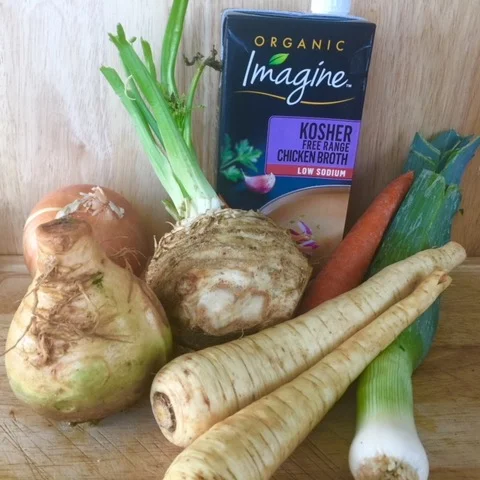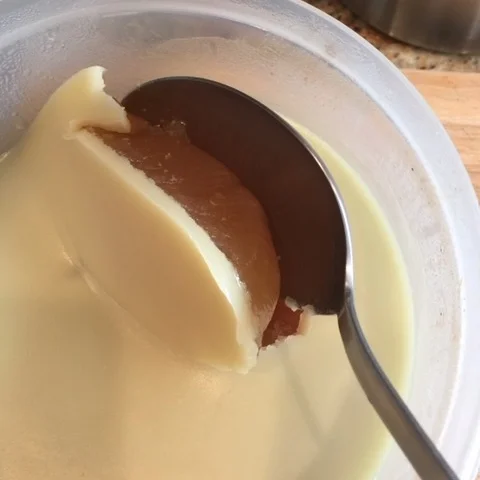Photo taken during Rosh Hashanah class at The Civic Kitchen in SF.
I couldn't very well give you a recipe for matzah balls without a soup to put them in. I decided to vary my soup this year. I wanted it to be more robust with deep, rich flavor. It isn't exactly traditional chicken soup--it's heartier with a bronzish golden hue.
People walked into my Rosh Hashanah cooking class saying they wouldn't change their bubbe's recipe that has been in their family for decades. I value cherishing tradition and keeping memories alive and am all for it. But after tasting this soup, the students admitted it was so tasty that it is truly worthy of varying tradition.
My soup is a combination of stock and broth. In 1974, James Beard wrote that stock, broth, and bouillon are all the same thing. But, oh my, how cooking terms have changed through the decades--and how confusing they've become.
To keep it brief, stocks are made primarily from animal bones (for chicken, neck, carcass, wing tips, feet) and therefore contain more gelatin, giving them a thicker, richer texture. Stocks are cooked longer than broth and therefore have a more intense flavor. They are left unseasoned for use in other recipes, while broth is salted and seasoned and can be eaten alone.
My soup falls somewhere in between both---after all, I can do whatever I want when I make up recipes. I want it to be eaten alone, like broth, yet it is rich and gelatinous and needs no seasoning, like stock. The chicken backs add a tremendous amount of flavor and gelatin. The color of the resulting soup is deeper than traditional chicken broth, but if you prefer a lighter color, use fewer backs.
Whether you choose to make bubbe's soup or give mine a try, I wish you L'Shana Tovah tikatevu. May the coming year be filled with everything good and sweet memories.
Use any type of broth you want. Rutabaga is on the left, celery root (or celeriac) in front of soup and behind parsnips.
To keep the broth from being cloudy, skim the scum (denatured protein) from the top. The more you remove, the clearer your broth will be.
After being refrigerated, it is easy to scrape the hardened fat off the top. The soup underneath will be gelatinous and full of flavor.
CHICKEN ROOT VEGETABLE SOUP
3 tablespoons schmaltz or vegetable oil
2 large onions, peeled and chopped
2 carrots, peeled and chopped
2 large leeks, white part only, cleaned and sliced
1 small celery root, peeled and chopped (about 1 cup)
1 cup peeled and chopped parsnip
1 cup peeled and chopped rutabaga,
12 whole peppercorns
2 lbs. chicken backs, necks and/or wings, cut in half, if large and fat removed
12 cups chicken broth
Salt and white pepper to taste, if needed
For serving (optional)
Matzah balls
Sliced cooked carrots
Finely chopped parsley
To cook soup: In a large soup over medium heat, heat schmaltz or oil until hot. Add onions, carrots and leeks. , Sauté, stirring often, until soft, about 15 minutes. Stir in celery root, parsnips, rutabagas, peppercorns and chicken. Cook, stirring for 2 minutes. Add chicken broth; stir. Bring to a boil, reduce heat to a simmer and cook, partially covered, stirring occasionally for 1½ to 2 hours.
Strain into a large bowl. Press on vegetables to extract as much broth as possible. Discard vegetables and soup into compost.
TO MAKE AHEAD: Soup may be refrigerated up to 3 days or frozen.Before serving: Scrape off any fat from top of broth. Reheat soup and season to taste. Add matzah balls, carrots and parsley, if desired.
Makes about 12 cups.





